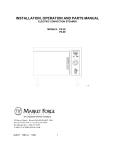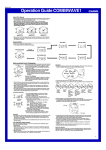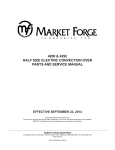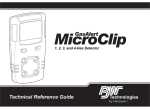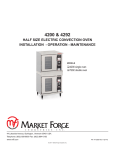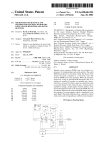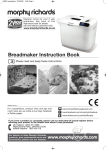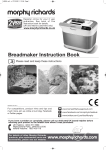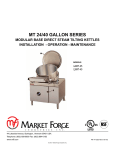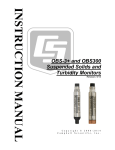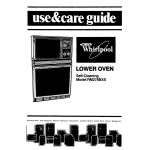Download Market Forge Industries 4292 Owner`s manual
Transcript
OWNER’S MANUAL ELECTRIC COMPACT CONVECTION OVEN MODELS: 4200 4292 FORM NO.: S-2374 REV: A PRINTED IN U. S. A. 02/07 An Employee Owned Company 35 Garvey Street • Everett • MA • 02149 Tel: (617) 387-47100 • Fax: 1-800-227-2659 (Ex. MA) • (617) 387-4456 (MA and Overseas) E-mail: [email protected] • Website: www.mfii.com TABLE OF CONTENTS INTRODUCTION DESCRIPTION.................................................................................................................................1 OVEN COMPONENTS ....................................................................................................................1 BASIC FUNCTIONING ....................................................................................................................1 SERVICE .........................................................................................................................................1 INSTALLATION RECEIVING .....................................................................................................................................2 ASSEMBLY - VENT BOX ATTACHMENT ........................................................................................2 SINGLE OVEN - 4” LEGS & 28” LEGS WITH SHELF . ...................................................................2 STACKED OVENS - 18” LEGS WITH SHELF .................................................................................3 ELECTRICAL CONNECTION . ........................................................................................................3 OVEN CHECKOUT & ADJUSTMENTS ...........................................................................................4 THERMOSTAT CALIBRATION (OLD & NEW STYLES) . ................................................................4 THERMOSTAT DIAL PLATE CALIBRATION (NEW STYLE) ...........................................................4 WIRING DIAGRAM ..........................................................................................................................5 OPERATION PRINCIPLES OF OPERATION . ......................................................................................................6 CONTROLS .....................................................................................................................................6 PRE-HEATING . ...............................................................................................................................6 OPERATION ....................................................................................................................................6 MAINTENANCE CLEANING . .....................................................................................................................................7 REMOVAL & REPLACEMENT PARTS ............................................................................................7 DOOR REMOVAL ............................................................................................................................7 DOOR REPLACEMENT (OLD STYLE)............................................................................................7 OVEN LINER GASKET REMOVAL .................................................................................................7 GASKET REPLACEMENT ..............................................................................................................7 BLOWER WHEEL REMOVAL & REPLACEMENT ..........................................................................7 MOTOR REMOVAL & REPLACEMENT ..........................................................................................7 SWITCH REMOVAL & REPLACEMENT .........................................................................................8 CONTACTOR REMOVAL & REPLACEMENT..................................................................................8 THERMOSTAT REMOVAL & REPLACEMENT ...............................................................................8 HEATER ELEMENT REMOVAL & REPLACEMENT .......................................................................8 DOOR INTERLOCK SWITCH BRACKET (OLD STYLE) REMOVAL & REPLACEMENT ..............................................................................................................................8 NEW STYLE INTERLOCK SWITCH REMOVAL, REPLACEMENT & PARTS.................................9 HI-LIMIT REMOVAL & REPLACEMENT .........................................................................................9 TROUBLE-SHOOTING GENERAL ........................................................................................................................................10 TROUBLE-SHOOTING GUIDE .......................................................................................................10 WIRING . ..........................................................................................................................................11 ELECTRICAL FAULT ISOLATION GUIDE . .....................................................................................11 ELECTRICAL CONNECTIONS - CONTROL BOARD .....................................................................12 ILLUSTRATED PARTS LIST GENERAL ........................................................................................................................................13 ORDERING INFORMATION . ..........................................................................................................13 4200 COMPACT CONVECTION OVEN & PARTS ..........................................................................13-14 CONTROL PANEL, OPEN & PARTS . ............................................................................................15 RIGHT SIDE VIEW & PARTS .........................................................................................................16 DOOR ASSEMBLY & PARTS .........................................................................................................17 INSIDE OVEN COMPARTMENT PARTS LIST ................................................................................18 4200/4292 REVERSING SWING OF DOOR (S) .............................................................................18 INTRODUCTION This service and parts manual contains general information, installation, operation, principles of operation, trouble-shooting and maintenance information for the Market Forge Model 4200 Electric Compact Convection Oven. Also included are parts lists, in which each replaceable part is identified and shown in an accompanying illustration. DESCRIPTION The Market Forge Model 4200 Electric Compact Convection Oven is an electrically powered convection oven designed to achieve high volume cooking with a minimum of power consumption. The unit consists of a heavily insulated cooking compartment fitted with a two speed convector blower and heated by electric elements. All oven controls are located on a panel on the right front of the oven as seen from the front. tors located in the control section close the circuit to heating elements located at the right of the cooking chamber. When the chamber reaches the preset temperature, the thermostat contacts open, causing the contractors to interrupt the circuit to the heating elements. When the temperature in the chamber drops enough to close the thermostat contacts, the circuit closes again. Any number of such cycles might occur during the cooking time, ~indicated by the element indicator light coming on and off. OVEN COMPONENTS The major assemblies of the model 4200 are the stainless steel and flat back painted steel cabinet enclosure, door with window, porcelain cooking compartment with nine-position shelf supports, heating element and contractor assembly, and control panel assembly. Controls and indicators include the thermostat, main power switch, blower speed switch, cool down/switch, elements on indicator light, 60-minute timer, and elements only switch. The oven is available in variety of mounting configurations: 4” 102mm high-legs, 27” 686mm legs with shelf, or stacked on top of another Model 4200 with the bottom unit on 18” 457mm stainless steel legs with shelf. SERVICE Required service, both preventive and corrective, is explained in section 5. Should repairs be required, a network of authorized agencies is available to assist with prompt service. A current directory of Authorized Service Agencies may be obtained by contacting: Product Service Department Market Forge Company 35 Garvey Street Everett, MA 02149-4403 (617) 387-4100 The model and serial number must be referenced when corresponding with Market Forge. The data plate with serial number is located on the right of the bottom front trim ledge. BASIC FUNCTIONING The Model 4200 becomes operational when the power switch is placed in the ON position, door is closed, and thermostat set. Contrac- * We recommend that service be performed by a qualified Market Forge Authorized Service. Service performed by others will void warranty. Market Forge is not responsible for repairs made by other than authorized service agents. 1 INSTALLATION RECEIVING 1. Examine shipment for external and internal damage and completeness. Transport crated oven through building, to installation area before unpacking. 2. 2. Report any damage or shortages to carrier and Market Forge immediately. 3. DO NOT AT ANY TIME LAY THE OVEN DOWN ON ITS TOP, RIGHT SIDE, OR FRONT. TO DO SO MAY DAMAGE THE EQUIPMENT AND VOID THE WARRANTY. ASSEMBLY - Vent Box Attachment 1. Remove steam vent box and packet of screws from inside oven and attach vent box to back of oven over vent opening using five #8 sheet metal screws. Single Oven on 4” Legs Fasten legs to the weld nuts located on bottom panel of oven. The hex foot on the leg is adjustable. Single Oven on 28” Legs with Shelf 1. Insert legs (Fig. 1 No. 3) through holes in shelf (Fig. 1 No. 1) Do not tighten setscrews in corners of shelf. 2. Screw leg tops (Fig. 1 No. 2) onto legs. (Fig. 1 No. 3) 3. Insert leg tops (Fig. 1 No. 2) through holes in angle iron frame (Fig. 1 No. 4) into weld nuts in bottom of oven. 4. Screw leg tops (Fig. 1 No. 2) into weld nuts by turning leg and top assemblies. 5. Raise shelf (Fig. 1 No. 1) to desired height and tighten set screws in shelf corners. 2 Fig. 1 ITEM PART NO. DESCRIPTION QTY. 1 99-6180 SOLID SHELF ST/ST 1 2 A10-0635 LEG TOP 4 3 A10-0634 FLOOR LEG 28” HIGH 4 4 D99-6183 SHELF 1 INSTALLATION Stacked Ovens on 18” Legs with Shelf Stacking Instructions: 1. Fasten Item No. 1, stacking channel, to the bottom left side of top oven. Note - left channel has (2) holes. Use nut & washer (Item 3 & 4) front & rear. 2. Remove access panel from the right side of both ovens. 3. Remove knockouts from the top of the bottom oven and from the bottom of the top oven. 4. Place upper oven on top of lower oven with the right side stacking channel placed between. Line up holes in both ovens with the holes in the channel. 5. Fasten ovens together with the washer (Item No. 4) and the bolt (Item No. 11) Inserted up thru top of lower oven, thru stacking channel and into bottom of upper oven, using the existing weld nut to fasten the rear and the nut provided with the stacking kit (Item No. 5) to fasten the front. ELECTRICAL CONNECTION: 1. Read data plate located on top surface of right side of bottom trim just below control panel before connecting electrical supply to oven. Make sure electrical supply is the same voltage, phase, and frequency called for on date plate. 2. All ovens are shipped three phase and may be converted to single phase as per alternate single phase wiring diagram. 3. Feed supply through opening in rear of oven (Fig. 2-1 No. 2) and connect supply wires to terminal block behind control panel. 4. Wiring diagram label is located on control bracket, accessible by opening control panel. NOTE: Improper connection to power supply or connection to power supply other than that designated on data plate will void the warranty. Assemble stand, as shown, before stacking ovens. 3 Fig. 2 ITEM PART NO. DESCRIPTION QTY. 1 B99-6203 Stacking Channel Left 1 2 B99-6204 1 3 10-2564 Stacking Channel Right Hex Bolt 3/4-10 x 1 1/2 Lg. 2 5 10-2320 Plain Washer - /4 Nut, Hex - 3/4 -10 6 99-6180 Solid Shelf 1 7 A09-5271 Floor Leg 18” High 4 8 A10-0635 Leg Top 4 9 D99-6183 Shelf 1 10 A25-3263 1 11 08-3426 Set Screw & Wrench Kit Hex Bolt 3/4-10 x 4 Lg. 4 10-2411 5 3 1 2 INSTALLATION OVEN CHECKOUT & ADJUSTMENTS: Door Adjustment (Old Style): The door was properly adjusted at the factory, if door does not open or close properly adjust the ball plunger catch as .follows: 1. 1. Remove adjusting wrench from back of manual and insert in notches on sides of ball plunger. 2. Loosen jam nut with wrench. 3. Turn adjusting wrench left or right until ball plunger engages in door striker plate for best operation. 4. Tighten jam nut with wrench while adjusting wrench is still engaged in notches. 5. Return adjusting wrench to back of manual. Thermostat Calibration (Old Style): The thermostat is a device which automatically limits heat input at or below the dial setting. 7. Repeat steps 4 to 7 until oven temperature stabilizes at 350°F+/- 5°F 8. Apply Glyptol or Duco Cement to set pot to prevent rotation. Thermostat Dial Plate Calibration (New Style): 1. Clamp thermocouple sensor in the center of the middle rack in compartment. 2. Pass the thermocouple sensor wire through the door gasket and close the door. 3. Plug the sensor lead into the pyrometer. 4. Set the oven power switch to ON. 5. Set the thermostat knob to 3500 (191°C). 6. Allow the oven to warm up for a minimum of (3) three ON/OFF cycles. Before attempting to calibrate thermostat, make sure that the thermostat is the cause of problems experienced. Check for improper electrical service, incorrect mixes over and under proofing, incorrect temperatures, and warping pans. Thermostats are calibrated and sealed by the original manufacturer before leaving their plant. Only a qualified service person should make calibration adjustments, if they become necessary. Calibrate Electronic Thermostat Fig. 3 (NEW Style): 7. Record the temperature when the element indicator light goes off. If a tempera1. Set oven thermostat knob at 350°F. ture of 345°-355° is attained, no calibra2. Allow oven to preheat to 350°F. tion is necessary . 3. Observe temperature with digital thermometer. 8. If the temperature differs more than +/5°F from the dial setting: 4. If temperature goes above 350°F turn set pot labelled HI (on circuit board) counter• Pencil mark the knob pointer position as a clockwise. % turn should be sufficient. reference point on the control panel next to the dial plate 5. Allow time for oven temperature to drop, then recheck temperature. • Loosen the dial plate mounting screws only enough to move the plate. 6. If temperature is below 350°F turn set pot labelled HI (on circuit board) clockwise.+/• Move the dial plate until calibration match5°F turn should be sufficient. es thermometer reading (350°F). 4 INSTALLATION 5 OPERATION PRINCIPLES OF OPERATION: Uniform distribution of heat within the oven is assured by continuous operation of a convector blower. Moving air continuously strips away a thin layer of moisture and cold air from the top of the food allowing more rapid heat penetration. Lower temperatures and shorter times than those used in conventional deck ovens ‘Can be used. In general, temperature settings can be reduced by 50°F (28°C) from recipe temperatures for conventional ovens. Some products may require slightly higher or lower temperatures. Product should be checked for doneness in about half the time it would take in a conventional oven. Time savings may be about 15% to 20%. CONTROLS: All controls for the Model 4200 oven are located on the control panel on the front of the oven (Fig. 5). These controls are; a thermostat to control oven temperature (Fig. 5 No. 1), an Elements On indicator light (Fig. 5 No. Fig. 5 2), a power switch with ON and OFF posi- OPERATION: tions (Fig. 5 No. 3), a blower switch with high 1. Set temperature about 50°F (28°C) less and low positions (Fig. 5 No. 4), a cool down than what recipe calls for when using switch with manual and auto positions (Fig. standard oven. 5 No. 5) and a 60 minute electro-mechanical 2. Load pans evenly on shelves making sure timer (Fig. 5 No. 6). Heating Elements Only pans don’t touch sides of oven or other Switch (Fig. 5 Not Shown). pans. 3. Check food for doneness in about half the PRE-HEATING: time it would take in a conventional deck oven. Visual inspection of food can be 1. Set thermostat to desired temperature, set blower switch to desired speed, and turn made without opening the door by looking on power switch. Blower wheel should rothrough tempered glass window. tate clockwise when viewed from front of 4. Blower will automatically shut off by a door oven. Low speed is suggested for fragile interlock switch when door opens. Closing products ie those levened by beaten egg the door will restart the blower. whites such as souffles, angel food cake 5. Blower may be operated with door open and popovers. by placing cool down switch in manual position. No power is suppled to heating 2. Indicator light will go out when desired temperature is reached. Oven will pre-heat to elements with cool down switch in manual 350°F 180°C in about 10 minutes. Large position, allowing rapid lowering of oven differences in time from this indicate faulty temperatures with door open. heating elements, or connection to wrong 6. Heating elements only without blower fan electric power supply. when door is shut. (For delicate products) 6 MAINTENANCE CLEANING: 1. Clean interior of oven with a commercially available oven cleaner suitable for use on porcelain. 2. Racks, rack supports, and blower wheel may be cleaned by soaking in ammonia and water solution after removing them from oven. 3. Stainless steel parts maybe cleaned using a commercially available stainless steel cleaner. OVEN LINER GASKET REMOVAL: 1. Remove all screws from gaskets. 2. Remove all gaskets. GASKET REPLACEMENT: 1. Replace top and bottom metal gaskets on front off oven liner and screw in place. 2. Replace left and right side metal gaskets and screw in place. BLOWER WHEEL REMOVAL: 1. Shut off main power supply. REMOVAL & REPLACEMENT OF PARTS: 2. Remove baffle by placing hard under back end and rotating baffle up and out. WARNING: Disconnect oven from main 3. Loosen set screws located in the center of power supply before working on oven. the blower wheel on the wheel hub. 4. Pull blower wheel off of shaft. DOOR REMOVAL: 1. Remove lower screw (Fig. 6, #1) from up- BLOWER WHEEL REPLACEMENT: per hinge assembly of door. 1. Remove metal burrs and foreign matter from motor shaft with emery cloth or sand2. Loosen top screw (Fig. 6, #2) from upper assembly. paper. 3. Push upper hinge pin (Fig. 6, #3) into 2. Lubricate blower wheel hub with high door. graphite grease. (Remove blower and lubricate at least once every six months). 4. Rotate top of door forward to clear upper frame. 3. Place blower wheel on shaft. Make sure set screws are positioned over the flats on 5. Pull up and out on door to remove. the shaft. Make sure there is 3/16” clearance between blower wheel and oven wall. 4. Tighten set screws to 160 in-lbs torgue. Fig.6 DOOR REPLACEMENT (OLD STYLE): Revere above procedure being sure to put as many washers under as there were before removal. 7 MOTOR REMOVAL: 1. Make sure main power supply is disconnected from oven. 2. Remove baffle and blower wheel. 3. Remove right side panel. 4. Open control compartment cover. 5. Remove motor bolt access plate. 6. Remove four nuts and blots holding motor to motor mount. 7. Remove cover from wiring box mount on motor and disconnect wires. MAINTENANCE MOTOR REPLACEMENT: 1. Revere procedure above. 2. Check motor wiring to make sure blower turns clockwise when seen from front of oven. SWITCH REMOVAL: 1. Make sure power supply to oven is off. 2. Open control compartment cover. 3. Disconnect wire to switch. 4. Depress spring clips on switch and push forward. SWITCH REPLACEMENT: 1. Push switch into proper control panel opening until spring clips catch. 2. Reconnect wire to switch. 3. Close control cover. CONTACTOR REMOVAL: 1. Make sure power supply to oven is off. 2. Open control comportment cover. 3. Disconnect wire from appropriate component. 4. Unscrew fasteners of appropriate components and remove. CONTACTOR REPLACEMENT: 1. Attach components to mounting. 2. Replace and tighten fasteners. 3. Reconnect wires. THERMOSTAT REPLACEMENT: Follow Thermostat Removal in reverse order. HEATER ELEMENT REMOVAL: 1. Make sure power supply to oven is off. 2. Remove right side panel. 3. Remove element terminal cover above motor and disconnect wires. 4. Remove element plate and insulation spacer. 5. Remove racks and rack supports from oven cavity. 6. Remove baffle. 7. Remove eight screws holding element assembly to the oven wall. 8. Remove elements. ELEMENT REPLACEMENT: Follow Element Removal in reverse order. DOOR INTERLOCK SWITCH BRACKET REMOVAL (OLD STYLE): Make sure power supply to oven is off. Open control compartment cover. Remove wires to door interlock switches. Remove two bracket retaining screws. Remove interlock switch assembly. DOOR INTERLOCK SWITCH BRACKET REPLACEMENT (OLD STYLE): 1. Insert long end of door activated plunger through hole in left front side of control THERMOSTAT REMOVAL: compartment. 1. Make sure power supply to oven is off. 2. Replace spring and switches in bracket and secure switch assembly with two 2. Open control compartment cover. screws. 3. Remove racks and rack supports from oven compartment. 3. Position switches so that push buttons on switches just touch actuator plate on 4. Remove baffle. plunger rod. 5. Disconnect thermocouple lead wires from circuit board. 4. Replace wires using wiring diagram as guide. 6. Unscrew thermocouple from oven liner. 7. Pull thermocouple and wires through oven 5. Replace control compartment cover. liner into oven compartment and remove. 8. Remove circuit board from bracket. 8 MAINTENANCE NEW STYLE INTERLOCK SWITCH REMOVAL: 1. Make sure power supply to oven is off. 2. Remove lower bottom trim, remove screws on end. 3. Remove screws from switch, to remove switch. 4. Remove marr connectors from leads, then remove switch. REPLACEMENT OF SWITCH: Follow New Style Interlock Switch Removal in reverse order. HI-LIMIT REMOVAL: 1. Make sure power supply to oven is off. 2. Open oven door. 3. Remove all shelves and rack supports. 4. Remove baffle from right sire. 5. Unscrew fasteners from Hi-Limit on liner wall and pull out. 6. Remove wire leads from Hi-Limit. HI-LIMIT REPLACEMENT: Follow Hi-Limit Removal in reverse order. Fig. 7 NEW STYLE INTERLOCK LOCATION 9 ITEM PART NO. DESCRIPTION 1 08-6308 Reed switch (fan interlock) 2 99-6168 Reed switch mounting bracket 3 REF. Marr connectors, two TROUBLE-SHOOTING GENERAL: The information in this section is intended to assist both the operator and service personnel in locating the general source of problems which may occur with the model 4200 compact convection oven. Before following any of the procedures gives in this section, the op- TROUBLE-SHOOTING GUIDE: PROBABLE CAUSE 1. Convector fan fails to operate. a. Power to oven is off. b. ON-OFF switch off. c. Oven door open. d. Faulty cool down switch ON-OFF switch, door switch, fan motor, wiring. erator should be thoroughly familiar with the operating instructions and the function of all controls described on page 6 of this manual. If the problem cannot be readily corrected, the operator should contact the nearest Authorized Market Forge Service Agency for assistance. REMEDY a. Locate external circuit breakers for power and place in ON position. b. Place in ON position. c. Close door. d. Test each component and connecting wire, replace as required. 2. Oven will not heat with thermostat at maximum setting, fan operating. a. Faulty thermostat wiring. a. Test thermostat and connecting wiring. b. Thermostat contacts or coil faulty. Replace as required. b. Replace thermostat. 3. Indicator light fails to light with thermostat set, fan operating, oven hot. a. Indicator light burned out. a. Replace light. b. Faulty wiring. b. Check wiring and repair as needed. 4. Erratic oven temperature. a. Faulty thermostat operation. a. Recalibrate or replace as required. 5. Uneven heating. a. One or more heating elements inopera- a. Check wiring to elements; check for tive. burned out elements. Replace as required. WE RECOMMEND THAT SERVICE BE PREFORMED BY A QUALIFIED MARKET FORGE AUTHORIZED SERVICER. SERVICE PERFORMED BY OTHERS WILL VOID WARRANTY. MARKET FORGE IS NOT RESPONSIBLE FOR REPAIRS MADE BY OTHER THAN AUTHORIZED SERVICE AGENTS. 10 TROUBLE-SHOOTING WIRING: All the electrical components of the model 4200 (ON-OFF switch, door switch, thermostat control, contactors, fan motor, and indicator light) are connected to each other by wiring shown on page 5. If all the electrical components are operating correctly and the incoming power has been checked, but the unit fails to operate, the fault lies in the wiring. Using an ohmmeter, wiring continuity between the connections, shown in the wiring diagram is readily verified. This is best done in stages, removing only those wires required for each continuity check. As each lead is replaced, it should be checked for evidence of corrosion and cleaned if necessary. All leads must be tightly attached to provide a good electrical connection. ELECTRICAL FAULT ISOLATION GUIDE FAILURE 1. Oven will not operate when the thermostat is set. 2. Intermittent operation of heaters. 3. Convector fan fails to operate. 4. Indicator light off, heater under power. 5. Uneven heating. 6. (Elements Only) fails to come on. FAULT LOCATION a. Incoming power b. Door switch c. Thermostat control d. ON-OFF switch e. Cool down switch f. Contactor g. Wiring a. Thermostat control b. Contactor coil c. Wiring a. Cool down switch b. ON-OFF switch c. Door Switch d. Fan motor e. Wiring a. Indicator light b. Wiring a. Heating elements b. Wiring a. Check switch b. Check hi-limit switch c. Check wiring WE RECOMMEND THAT SERVICE BE PREFORMED BY A QUALIFIED MARKET FORGE AUTHORIZED SERVICER. SERVICE PERFORMED BY OTHERS WILL VOID WARRANTY. MARKET FORGE IS NOT RESPONSIBLE FOR REPAIRS MADE BY OTHER THAN AUTHORIZED SERVICE AGENTS. 11 TROUBLE-SHOOTING ELECTRICAL CONNECTIONS CONTROL BOARD: Fig. 8 NOTE: New style board CANNOT BE CALIBRATED. Check thermocouple for fault in temperature control. If thermocouple is good, replace temperature control board. 12 ILLUSTRATED PARTS LIST GENERAL: This section contains a complete listing of all replaceable parts for the 4200 compact convection oven. For the purpose of parts identification, the unit is broken down into functional assemblies, and each assembly is shown in a pictorial view which is keyed to the accompanying part list. Each parts list contains the figure item number, the Market Forge part number and an abbreviated description. ORDERING INFORMATION: Orders for repair parts should be directed to the nearest authorized parts distributor. For a current Market Forge Authorized Parts and Service Distributor list go to our web site or contact: Market Forge Industries Inc. Toll Free: (866) 698-3188 www.mfii.com Parts, Service and Availability Toll Free No.: (888) 259-7076 Fig. 9 13 ILLUSTRATED PARTS LIST Fig. 9 4200 Compact Convection Oven ITEM NO. PART NO. DESCRIPTION 1 2 3 4 5 99-5826 09-5268 09-6440 09-7231 09-7244 CONTROL PANEL K-MART ONLY THERMOSTAT KNOB RED PILOT 250V SWITCH DPDT 250V, 10 AMP, RED, ON-OFF SWITCH SWITCH DPDT 250V, 10 AMP, BLUE, BLOWER SWITCH 6 7 8 9 10 11 12 13 14 14A 15 15A 16 17 18 19 20 21 22 09-7235 09-7231 08-5839 99-5830 99-6136 99-6101 09-5269 09-7259 09-7241 09-7242 097336 09-7337 99-6102 99-6130 99-5054 99-5055 99-6107 09-5267 08-6351 SWITCH DPDT 250V, 10 AMP, WHITE, COOL DOWN SWITCH SWITCH DPDT 250V, 10 AMP, RED, HEATING ELEMENTS ONLY THERMOSTAT DECAL TIMER DECAL SIDE GASKET TOP AND BOTTOM GASKET BLOWER WHEEL THERMOCOUPLE AND WASHER HEATING ELEMENT, OUTER, 280V-2500W, 220V-2800W (EXPORT) HEATING ELEMENT, OUTER, 230V-2571W, 240V-2800W HEATING ELEMENT, INNER, 280V-2500W, 220V-2800W HEATING ELEMENT, INNER, 230V-2571W, 240V-2800W HEATING ELEMENT BRACKET BAFFLE SUPPORT BOTTOM TRIM TOP TRIM OVEN INTERIOR COVER PLATE 60 MINUTE TIMER KNOB HI-LIMIT THERMOSTAT 14 ILLUSTRATED PARTS LIST Fig. 10 Fig. 10 Control Panel, Open ITEM NO. PART NO. DESCRIPTION 1 2 3 4 5 10-6293 REF. 10-6649 10-5551 99-5822 60 MINUTE TIMER, 240V, 50/60 HZ REMOTE POTENTIOMETER, PART OF THERMOSTAT 08-6355 TERMINAL BLOCK GROUND LUG CONTROL CIRCUIT WIRE HARNESS 6 6A 7 10-5476 10-5943 08-6355 CONTACTOR, 280V, 40 AMP, 50/60 HZ CONTACTOR, 240V, 40 AMP, 50/60 HZ TEMPERATURE CONTROLLER, 208 OR 240V 15 ILLUSTRATED PARTS LIST Fig. 11 Fig. 11 Right Side View ITEM NO. PART NO. DESCRIPTION 1 2 3 4 5 09-7230 REF. REF. 10-6874 REF. BLOWER MOTOR, 208/230V, 1/4 HP, 2 SPEED TEMPERATURE CONTROLLER, 208-240V TERMINAL BLOCK S.P.S.T. RELAY, FOR REED SWITCH, 240V CONTACTOR, 208V, 40 AMP, 50/60 HZ 6 6A 7 8 8A 99-6108 99-6109 99-6140 09-6516 09-6599 HEATING ELEMENT COVER PLATE HEATING ELEMENT COVER GASKET ASSEMBLY, BLOWER MOTOR AND BRACKET SIREN AUDIO ALERT, 120V 6.8 K CERAMIC RESISTOR FOR ALTER, NOT SHOWN 16 ILLUSTRATED PARTS LIST Fig. 12 Fig. 12 Door Assembly ITEM NO. PART NO. DESCRIPTION 1 2 3 4 5 08-5205 REF. 99-6115 99-6170 99-6153 DOOR HANDLE ASSEMBLY CATCH, PART OF 08-5205 SPACER CATCH DOOR ASSEMBLY HINGE PIN 6 99-6154 HINGE PIN PLATE 17 ILLUSTRATED PARTS LIST INSIDE OVEN COMPARTMENT PART NO. DESCRIPTION 99-5027 99-5057 99-5056 99-5052 99-5058 BAFFLE RACK SUPPORTS RACKS EXTERIOR TOP PANEL EXTERIOR REAR PANEL 99-5020 99-5035 10-0633 99-6176 99-6177 RIGHT SIDE ACCESS PANEL LEFT SIDE PANEL 4” ADJUSTABLE LEGS 28” HIGH STAND 18” STACKED KIT WITH STAND 4200/4292 REVERSING SWING OF DOOR (S): 1. Remove door handle, P/N 08-5205, by removing three slotted screws located on edge of handle. 2. Loosen two upper hinge pin screws. Pin will drop into door. 3. Remove door by tilting top of door outward while lifting door off of lower hinge pin. 4. Remove catch plate assembly from face of oven. 5. Remove four round head machine screws from opposite side of oven face. 6. Re-install on other side of oven face, the four round head machine screws removed in step 5. 7. Re-locate and install catch plate assembly at new location. 8. Hold door in new position and allow hinge pin to slide out. Tighten two screws to hold pin in this position. 9. Release the (new) top hinge pin and re-install door in the new position. Push up hinge pin and tighten two screws to hold upper hinge pin in place. 10. Replace handle using hardware removed in step 1. 11. Adjust door by resetting adjustment on catch plate assembly. 18




















